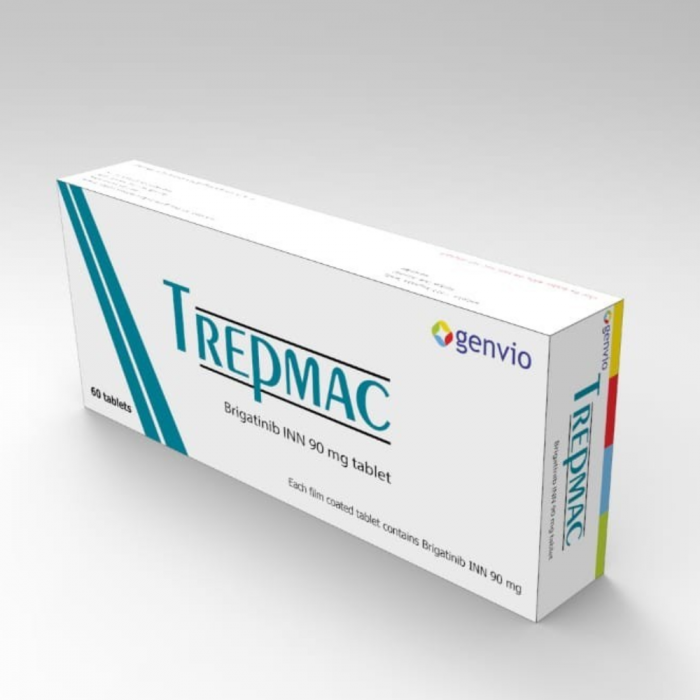
✔ 100% Authentic Product
👁️ Currently Viewing 1819
Alunib 180mg Tablet is prescribed for adults with non-small cell lung cancer (NSCLC).
- Specifically indicated for NSCLC with a particular type of abnormal gene called anaplastic lymphoma kinase (ALK).
Discount
Price: ৳ 58,800
MRP:
৳
60000
2%
Off

100% Genuine Products, Guaranteed

Safe & Secure Payments, Always

Fast, Secure & Efficient Delivery

Proper Packaging
 Cash on Delivery - All over Bangladesh
Cash on Delivery - All over Bangladesh Regular Delivery - 12-24 Hours, Dhaka City* Charge Tk.39-59
Regular Delivery - 12-24 Hours, Dhaka City* Charge Tk.39-59 Regular Delivery - 24-48 Hours, Other Cities* Charge Tk.99-110
Regular Delivery - 24-48 Hours, Other Cities* Charge Tk.99-110
 ফ্রি ডেলিভারিঃ - ৯৯৯ টাকা+ অর্ডারে, ঢাকা
শহরে
ফ্রি ডেলিভারিঃ - ৯৯৯ টাকা+ অর্ডারে, ঢাকা
শহরে ফ্রি ডেলিভারিঃ - ২৯৯৯ টাকা+ অর্ডারে, ঢাকার
বাহিরে
ফ্রি ডেলিভারিঃ - ২৯৯৯ টাকা+ অর্ডারে, ঢাকার
বাহিরে
100% Genuine Products, Guaranteed
Safe & Secure Payments, Always
Fast, Secure & Efficient Delivery
Proper Packaging
 Cash on Delivery - All over Bangladesh
Cash on Delivery - All over Bangladesh Regular Delivery - 12-24 Hours, Dhaka City* Charge Tk.39-59
Regular Delivery - 12-24 Hours, Dhaka City* Charge Tk.39-59 Regular Delivery - 24-48 Hours, Other Cities* Charge Tk.99-110
Regular Delivery - 24-48 Hours, Other Cities* Charge Tk.99-110 ফ্রি ডেলিভারিঃ - ৯৯৯ টাকা+ অর্ডারে, ঢাকা
শহরে
ফ্রি ডেলিভারিঃ - ৯৯৯ টাকা+ অর্ডারে, ঢাকা
শহরে ফ্রি ডেলিভারিঃ - ২৯৯৯ টাকা+ অর্ডারে, ঢাকার
বাহিরে
ফ্রি ডেলিভারিঃ - ২৯৯৯ টাকা+ অর্ডারে, ঢাকার
বাহিরে
✅ Description:
When a person breathes in, the lungs absorb oxygen from the air and transport it into the bloodstream for distribution throughout the body. As the body's cells utilize oxygen, they release carbon dioxide, which is carried back to the lungs by the bloodstream and expelled from the body during exhalation.
The lungs consist of various cell types, with epithelial cells being the predominant ones. Epithelial cells line the airways and produce mucus, serving to lubricate and protect the lungs. Additionally, the lungs contain nerve cells, hormone-producing cells, blood cells, and structural or supporting cells.
Regarding non-small cell lung cancer (NSCLC), there are two primary classifications of lung cancer, the other being small cell lung cancer, each requiring different treatment approaches. NSCLC originates when healthy lung cells undergo abnormal growth, forming a mass known as a tumor, lesion, or nodule. These growths can be either benign or cancerous. Cancerous lung tumors may shed cells that travel through the bloodstream or lymphatic fluid, potentially leading to metastasis in lymph nodes or distant parts of the body.
NSCLC comprises different subtypes, and understanding the specific type is crucial for determining appropriate treatment strategies. The classification is based on microscopic examination and the cell origin of the cancer. The main types of NSCLC include:
- Adenocarcinoma: Originating in epithelial cells lining the outer lungs that produce mucus, this is the most common type, accounting for approximately 40% of NSCLC cases.
- Squamous cell carcinoma: Arising from flat cells lining the lung's interior, known as squamous cells, this type constitutes around 30% of NSCLC cases.
- Large cell carcinoma: Characterized by large cells that differ from adenocarcinoma or squamous cell carcinoma, this is the least common NSCLC type. Advances in diagnostic tools may reclassify some cases as adenocarcinoma or squamous cell carcinoma.
NSCLC-NOS (not otherwise specified) or NSCLC undifferentiated: In certain instances, determining the specific NSCLC subtype remains challenging even after testing.
✔️ Uses of Alunib 180mg Tablet
Non-Small Cell Lung Cancer
✔️ Side Effects of Alunib 180mg Tablet
- Interstitial Lung Disease (ILD)
- Pneumonitis Hypertension
- Bradycardia
- Visual Disturbance Creatine
- Phosphokinase (CPK) Elevation
- Pancreatic Enzyme Elevation
✔️ Quick Suggestions:
- Non-small cell lung cancer is a disease in which malignant (cancer) cells form in the tissues of the lung.
- There are several types of non-small cell lung cancer.
- Smoking is the major risk factor for non-small cell lung cancer.
- Signs of non-small cell lung cancer include a cough that doesn't go away and shortness of breath.
- Tests that examine the lungs are used to diagnose and stage non-small cell lung cancer.
- If lung cancer is suspected, a biopsy is done.
- Certain factors affect prognosis (chance of recovery) and treatment options.
- For most patients with non-small cell lung cancer, current treatments do not cure the cancer.
✔️ Indication of Alunib 180mg Tablet
Anaplastic lymphoma kinase positive metastatic non-small cell lung cancer (ALK+ NSCLC) is a relatively rare subtype, constituting only 3-5% of all non-small cell lung cancer (NSCLC) cases. Despite its low prevalence, the significance of ALK mutations and their presence in various oncogenic fusion proteins, both in solid tumors and hematologic malignancies, underscores their importance as potential targets for cancer therapy. The primary driver of ALK-related NSCLC cases is the fusion gene EML4-ALK, which results from the fusion of the ALK gene with the echinoderm microtubule-associated protein like-4 (EML4). The original function of EML4 involves the proper formation of microtubules.
The presence of the EML4-ALK fusion gene leads to the formation of an aberrant fusion protein, disrupting normal signaling pathways. This abnormal signaling contributes to increased cell growth, proliferation, and survival. Crizotinib is a drug indicated for the treatment of ALK+ NSCLC; however, its efficacy is compromised in cases where ALK kinase domain mutations are present, as they confer resistance to the treatment.
In such instances, brigatinib emerges as a therapeutic option for patients with ALK+ NSCLC who either exhibit intolerance to Crizotinib or have experienced disease progression on this treatment. Brigatinib's role lies in its ability to target ALK, providing an alternative treatment avenue for patients with ALK+ NSCLC.
✔️ Pharmacology
Brigatinib is a tyrosine kinase inhibitor that exhibits in vitro activity at clinically achievable concentrations against multiple kinases.
- Targets various kinases, including ALK (anaplastic lymphoma kinase), ROS1, IGF-1R (insulin-like growth factor-1 receptor), FLT-3, and EGFR (epidermal growth factor receptor) with in vitro activity.
- Inhibits autophosphorylation of ALK, preventing its activation.
- Suppresses ALK-mediated phosphorylation of downstream signaling proteins, including STAT3, AKT, ERK1/2, and S6 in both in vitro and in vivo assays.
- Exhibits in vivo antitumor activity against specific mutant forms of EML4-ALK, including G1202R and L1196M mutants. These mutants are commonly found in non-small cell lung cancer (NSCLC) tumors in patients who have progressed on crizotinib.
- Reduces tumor burden and prolongs survival in mice implanted intracranially with an ALK-driven tumor cell line.
✔️ Dosage & Administration of Alunib 180mg Tablet
Initial Dosing:
- Start with 90 mg orally once daily for the first 7 days.
Dose Adjustment:
- If the 90 mg dose is tolerated during the first 7 days, increase the dose to 180 mg orally once daily.
Duration of Treatment:
- Administer Brigatinib until disease progression or until unacceptable toxicity occurs.
Treatment Interruption:
- If Brigatinib is interrupted for 14 days or longer for reasons other than adverse reactions, resume treatment at 90 mg once daily for 7 days.
Administration Instructions:
- Brigatinib may be taken with or without food.
- Instruct patients to swallow tablets whole; tablets should not be crushed or chewed.
Missed Dose or Vomiting:
- If a dose is missed or vomiting occurs after taking a dose, an additional dose should not be administered.
- The next scheduled dose of Brigatinib should be taken at the planned time.
Pediatric Use:
- The safety and efficacy of Brigatinib in pediatric patients have not been established.
✔️ Interaction
Brigatinib metabolism is affected by cytochrome P450 3A (CYP3A) enzymes, and interactions with drugs that modulate CYP3A activity can impact its plasma concentrations and efficacy. Here are some important considerations:
Increased Plasma Concentrations and Adverse Reactions with Strong CYP3A Inhibitors:
- Co-administration of brigatinib with strong CYP3A inhibitors, such as certain antivirals (boceprevir, cobicistat, indinavir, lopinavir, nelfinavir, ritonavir, saquinavir), macrolide antibiotics (clarithromycin), and antifungals (itraconazole, ketoconazole, posaconazole, voriconazole), as well as conivaptan, can increase plasma concentrations of brigatinib.
- Grapefruit or grapefruit juice can also inhibit CYP3A and increase brigatinib concentrations, leading to a higher risk of adverse reactions.
Decreased Plasma Concentrations and Efficacy with Strong CYP3A Inducers:
- Co-administration of brigatinib with strong CYP3A inducers, such as rifampin, carbamazepine, phenytoin, and St. John's Wort, can decrease brigatinib plasma concentrations, potentially leading to reduced efficacy.
Decreased Concentrations and Loss of Efficacy of CYP3A Substrates:
- Brigatinib may decrease plasma concentrations of CYP3A substrates, such as hormonal contraceptives, potentially leading to loss of efficacy.
✔️ Contraindications
Hypersensitivity to Brigatinib or any other components.
✔️ Pregnancy & Lactation
The use of brigatinib during pregnancy can potentially cause fetal harm, as demonstrated by findings in animal studies. Administration to pregnant rats during the organogenesis period resulted in dose-related skeletal anomalies at relatively low doses. Specifically, skeletal anomalies were observed at doses as low as 12.5 mg/kg/day, which is approximately 0.7 times the human exposure at a dose of 180 mg once daily. Additionally, higher doses (25 mg/kg/day or greater) were associated with increased postimplantation loss, malformations, and reduced fetal body weight.
Regarding fertility, brigatinib may lead to reduced fertility in males based on findings in male reproductive organs in animal studies. Therefore, individuals of reproductive potential, both males and females, should use effective nonhormonal contraception during treatment with brigatinib. Females need to continue contraception for at least 4 months after the final dose, and males should use effective contraception for at least 3 months after the last dose due to potential genotoxicity.
The distribution of brigatinib in human breast milk is unknown. Due to the potential for adverse reactions in breastfed infants, lactating women are advised not to breastfeed during treatment with brigatinib and for at least 1 week following the final dose. This precaution is taken to minimize the risk of exposing the infant to the medication and its potential effects.
✔️ Precautions & Warnings
- Patients should be monitored for signs and symptoms of ILD or pneumonitis. Treatment should be withheld or discontinued based on the severity of ILD or pneumonitis.
- Patients may experience high blood pressure (hypertension) during treatment. Discontinuation may be necessary in cases of Grade 4 hypertension or recurrence of Grade 3 hypertension.
- Brigatinib may cause slow heart rate (bradycardia). Caution is advised when used in combination with antihypertensive agents causing bradycardia. Life-threatening bradycardia may require discontinuation of treatment.
- Patients may experience visual disturbances, including blurred vision, diplopia, and reduced visual acuity.
- Treatment should be withheld in cases of Grade 3 or 4 CPK elevation or Grade 3 or 4 pancreatic enzyme elevation. Inadequate hyperglycemic control may also lead to treatment withholding.
- Hyperglycemia may occur, and blood sugar levels should be monitored. Hyperglycemic control should be adequate, and treatment may be withheld if necessary.
- Females of reproductive potential should use effective non-hormonal contraception during treatment and for at least 4 months following the final dose. Males with female partners of reproductive potential should also use effective contraception during treatment and for at least 3 months after the last dose.
- Brigatinib may cause fetal harm, and effective contraception is recommended for females of reproductive potential. Breastfeeding is not recommended during treatment and for 1 week following the final dose.
- The safety and efficacy of brigatinib in children have not been established.
✔️ Storage Conditions
Keep below 30°C temperature, away from light & moisture. Keep out of the reach of children.
⚠️Disclaimer:
At ePharma, we’re committed to providing accurate and accessible health information. However, all content is intended for informational purposes only and should not replace medical advice from a qualified physician. Please consult your healthcare provider for personalized guidance. We aim to support, not substitute, the doctor-patient relationship.












